Punctuation marks are essential symbols in English that help clarify meaning, show pauses, and organize sentences. Learning punctuation rules—like how to use periods, commas, question marks, colons, and apostrophes—improves writing accuracy and reading flow. This guide supports students, ESL learners, and teachers in mastering sentence structure, grammar clarity, and formal writing. Aligned with academic English standards, it simplifies each mark’s function using examples and definitions. Proper punctuation boosts communication, exam performance, and grammar confidence across school, email, and professional writing.
Rules of Punctuation Marks
The art of separating composition by means of the marks into clauses and parts of sentences is called Punctuation. The punctuation has following marks.
(1) Full Stop or Period (.)
(2) Colon
(3) Semi Colon (;)
(4) Comma (,)
(5) Mark of Interrogation (?)
(6) Mark of Exclamation (!)
(7) Dash (-)
(8) Inverted Commas (“”)
(9) Parenthesis [()]
(10) Hyphen (_)
(11) Apostrophe (‘)
(12) Capital Letters (A to Z)
Full Stop or Period (.)
| Rule | Example |
|---|---|
| It is used at the end of a sentence. | A cynic is a man who knows the price of everything but the value of nothing. |
| It is used in courtesy titles and abbreviations of rank. | Mr. Amjad Qureshi, Mrs. Salma Rahim |
| It is used with many abbreviations. | P.M., etc., i.e., Mon., Jan., M.P., M.D., D.S.R., F.D.R. |
| It is used before academic degrees when abbreviated. | M.B.B.S., Ph.D., L.L.B. |
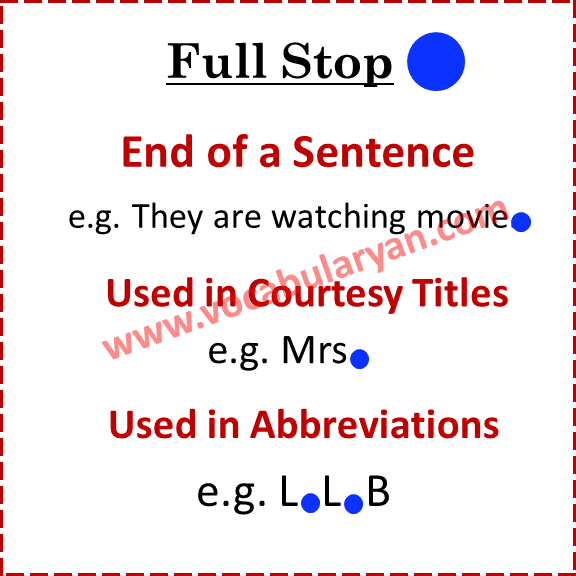
Colon ( : )
| Rule | Example |
|---|---|
| It introduces a list, explanation, or quotation. | He bought the following: bread, milk, and eggs. |
| It separates two independent clauses when the second explains the first. | She had one goal: to win the competition. |
| It can introduce formal statements or definitions. | The formula for water is: H₂O. |
| It is used before examples or clarifications. | He was good at all sports: basketball, football, and tennis. |
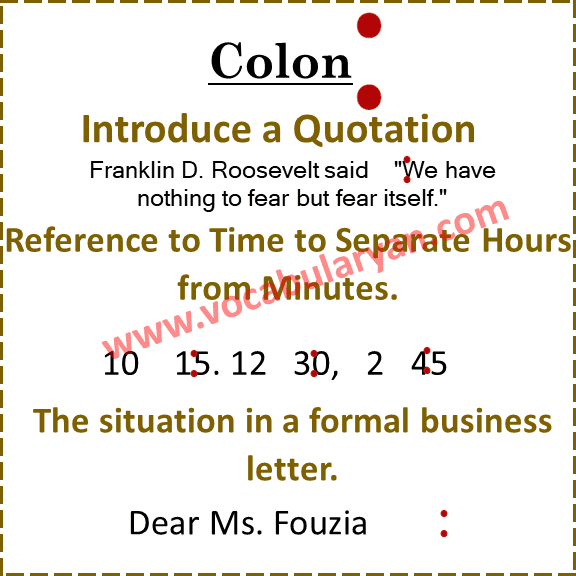
Semi Colon ( 😉
| Rule | Example |
|---|---|
| It connects closely related independent clauses. | I went to the market; it was already closed. |
| It separates items in a complex list. | We met at Lahore, Pakistan; Dubai, UAE; and Istanbul, Turkey. |
| It is used when the second clause provides additional information. | I enjoy reading; my brother prefers watching movies. |
| It is used before conjunctive adverbs in compound sentences. | I wanted to go to the park; however, it started raining. |
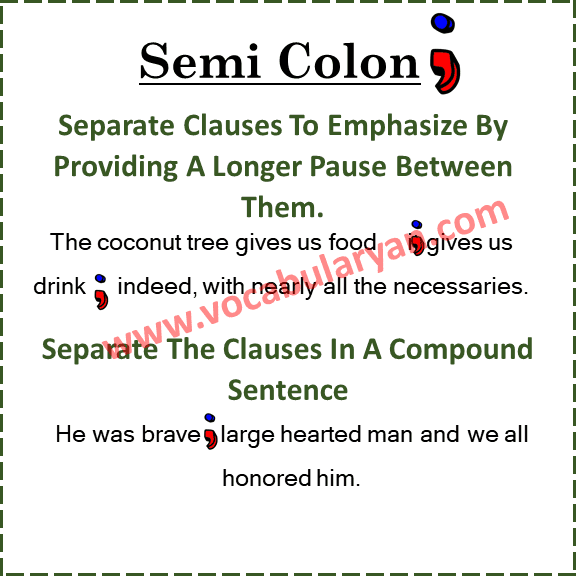
Comma (,)
| Rule | Example |
|---|---|
| It separates items in a list. | I bought apples, oranges, bananas, and grapes. |
| It is used after introductory words. | Yes, I will come to the meeting. |
| It separates clauses in compound sentences. | She was tired, but she finished her homework. |
| It is used for direct address. | Ali, can you help me? |
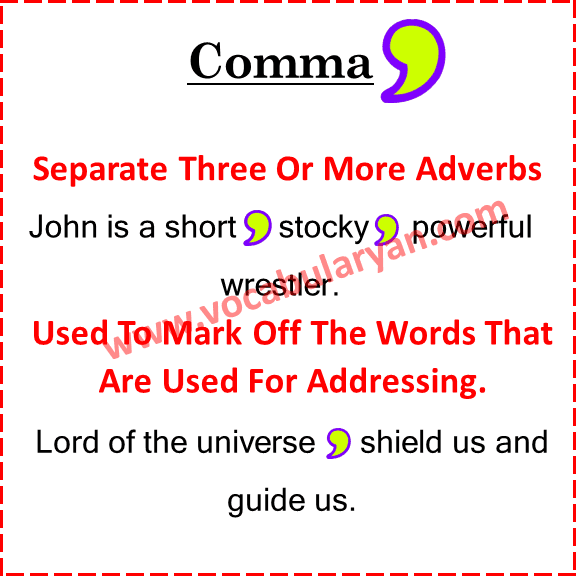
Mark of Interrogation ( ?)
| Rule | Example |
|---|---|
| It is placed at the end of a direct question. | Where are you going? |
| It is not used after indirect questions. | He asked where I was going. |
| It is used after yes/no questions. | Did you see the movie? |
| It indicates uncertainty or doubt. | Are you sure this is the right decision? |
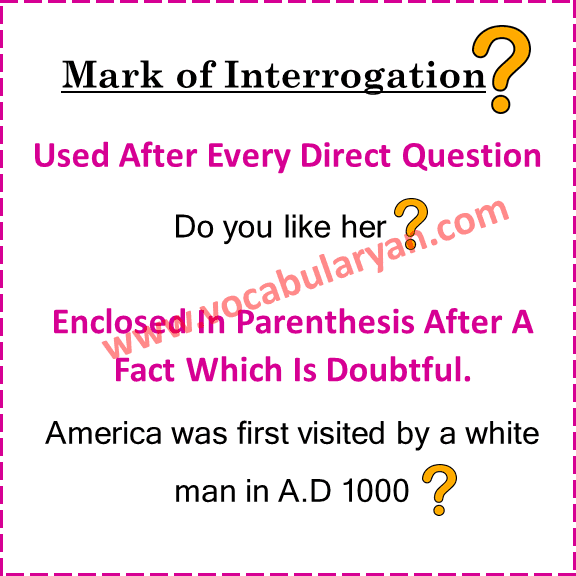
Mark of Exclamation (!)
| Rule | Example |
|---|---|
| It shows strong emotion or surprise. | What a beautiful view! |
| It is used for commands or interjections. | Stop! Wow! Congratulations! |
| It adds emphasis to an exclamation or interjection. | Wow! That’s incredible! |
| It is used in informal writing to express excitement or surprise. | I can’t believe it! |
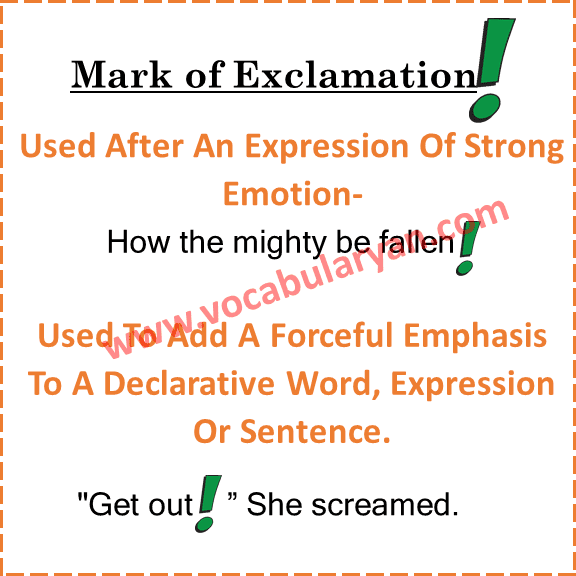
Dash ( -)
| Rule | Example |
|---|---|
| It is used to indicate a break in thought or an interruption. | She was going to tell him—then she hesitated. |
| It can emphasize additional information or an afterthought. | I need to buy groceries—especially eggs and milk. |
| It replaces commas or colons for a more informal tone. | The meeting was cancelled—no one showed up anyway. |
| It is used to separate parenthetical statements or explanations. | The book—although difficult—was worth reading. |
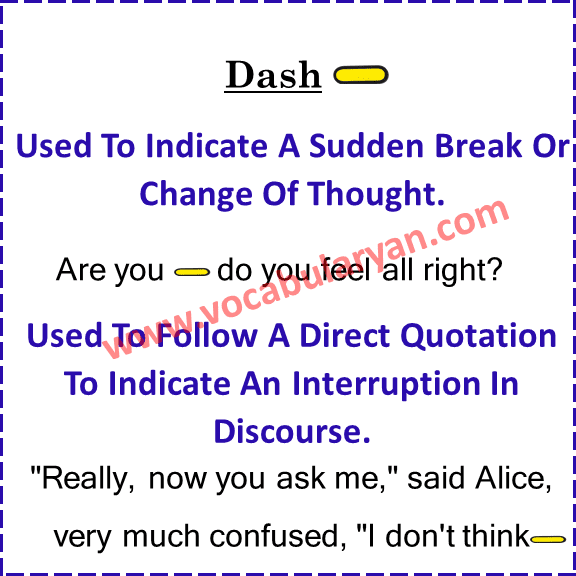
Inverted Commas (“ “)
| Rule | Example |
|---|---|
| They enclose direct speech or quotations. | He said, “I will be there at 5.” |
| They are used for titles of short works. | I read “The Gift of the Magi” in class. |
| They can indicate irony or special meaning. | The “easy” task took hours to complete. |
| They are used to highlight a specific word or phrase. | She called him a “genius” after the presentation. |
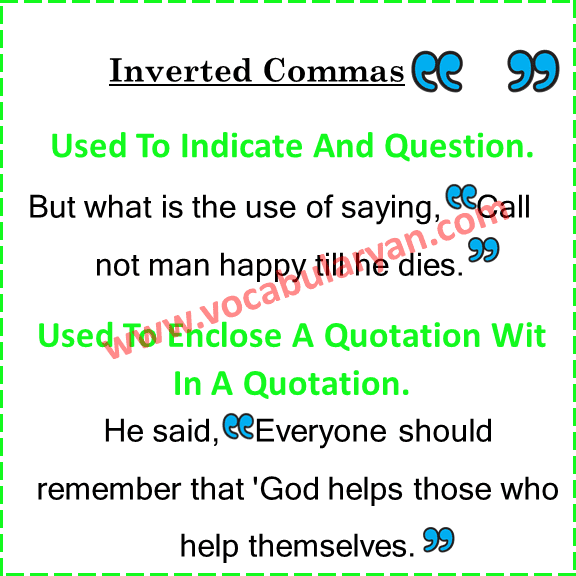
Parenthesis ([ ])
| Rule | Example |
|---|---|
| They are used to add extra information or an aside that is not essential to the main point. | I visited Paris last summer (it was my first time in Europe). |
| They set off citations or references in academic writing. | The study showed significant improvement in students’ grades (Smith, 2020). |
| They can enclose abbreviations or acronyms for clarity. | The United Nations (UN) has many peacekeeping missions. |
| They can be used for additional explanations or clarifications. | He finally answered the phone (after three missed calls). |
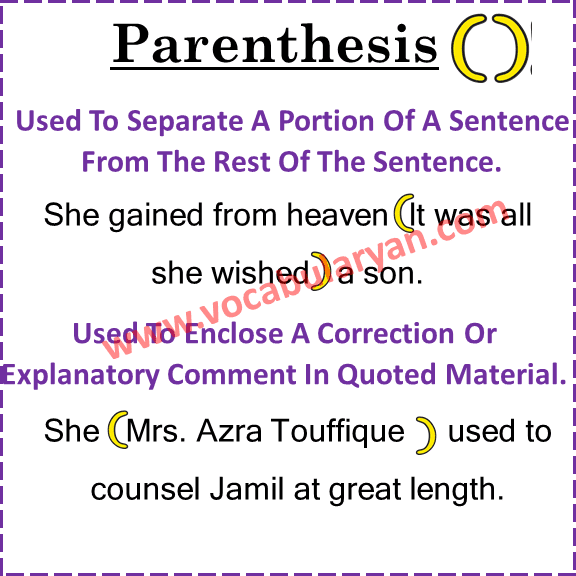
Hyphen ( – )
| Rule | Example |
|---|---|
| It is used to join compound words or compound adjectives. | She is a well-known author. |
| It is used to avoid ambiguity in compound numbers. | Twenty-three students attended the seminar. |
| It is used in compound nouns to form a single idea. | He is a full-time worker. |
| It is used to break words at the end of a line when necessary. | I didn’t ex-pect that outcome. |
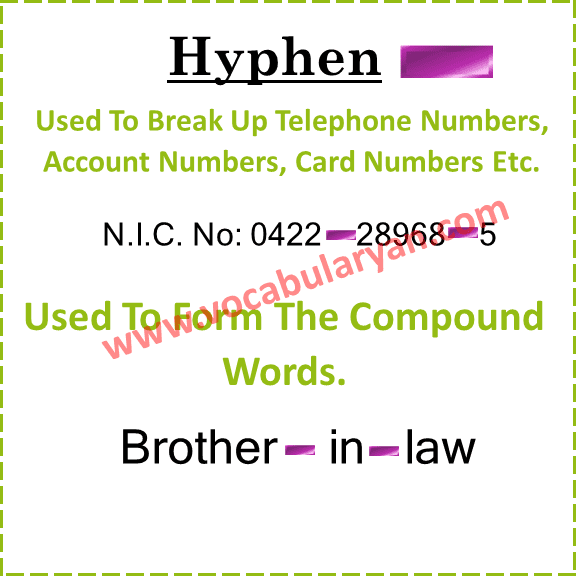
Apostrophe (‘)
| Rule | Example |
|---|---|
| It shows possession. | This is Sara’s book. |
| It forms contractions. | I can’t go today. He’s coming later. |
| It is used for plural possession. | The children’s toys were scattered around the room. |
| It is not used in possessive pronouns. | The dog wagged its tail. |
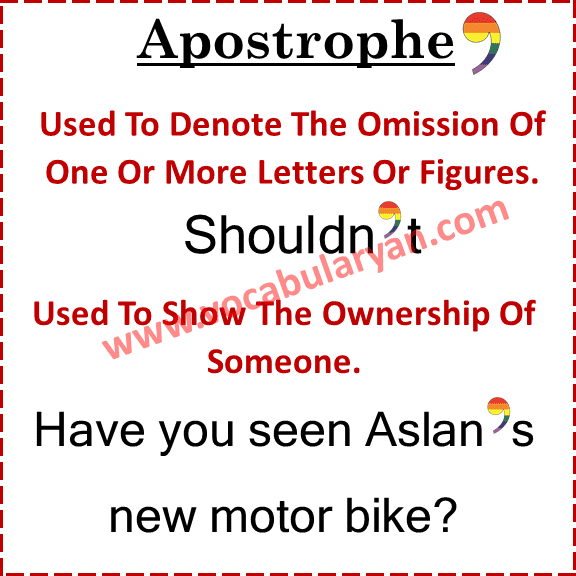
Punctuation Marks Chart
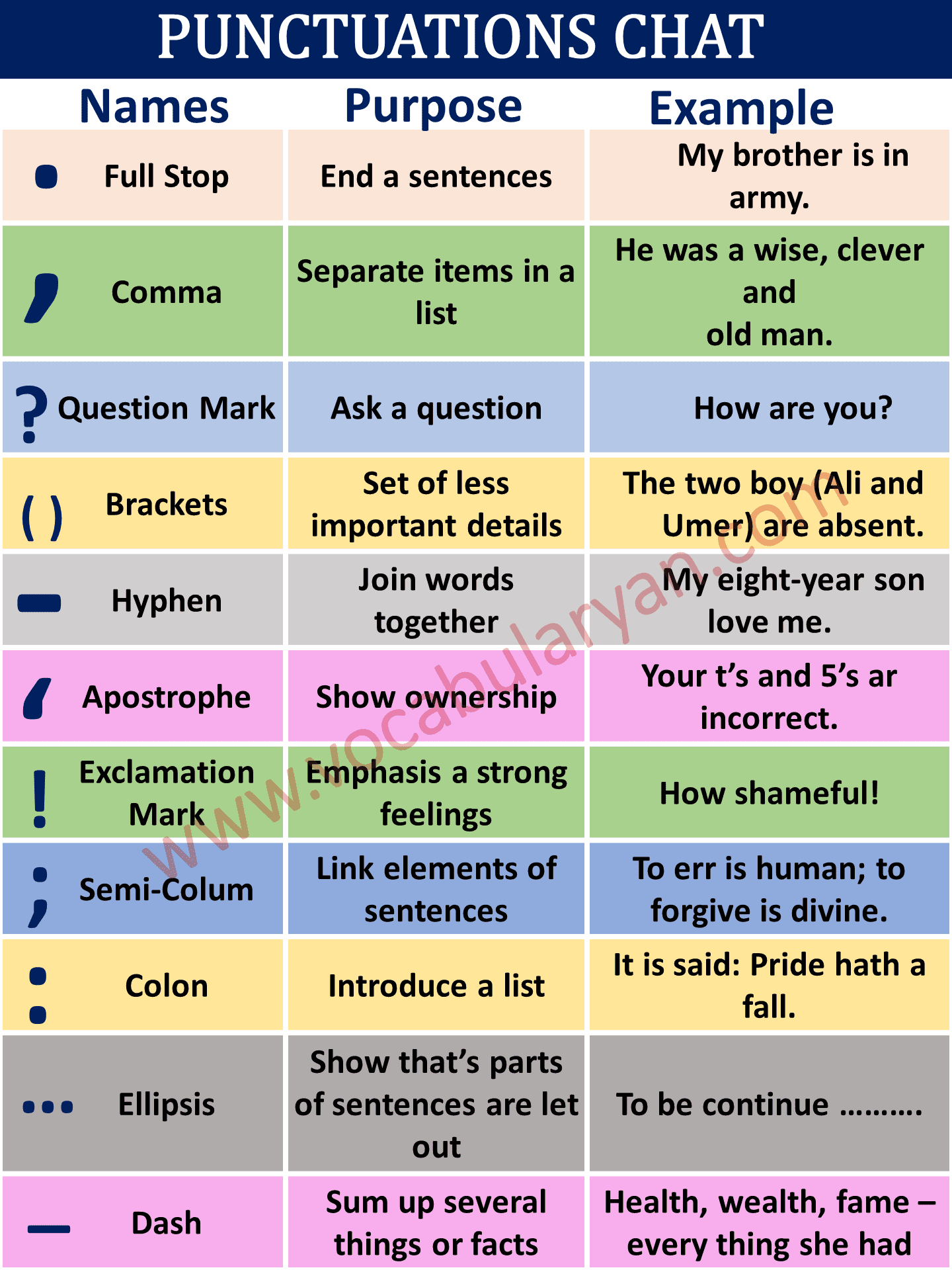
You May Also Like

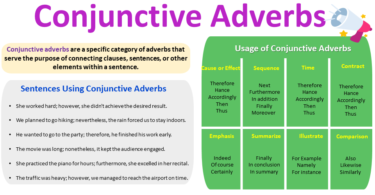
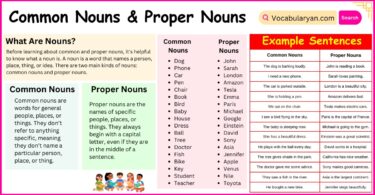
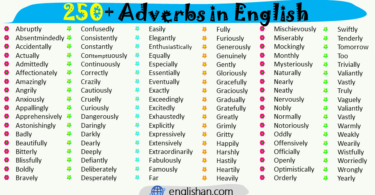
Leave a Comment